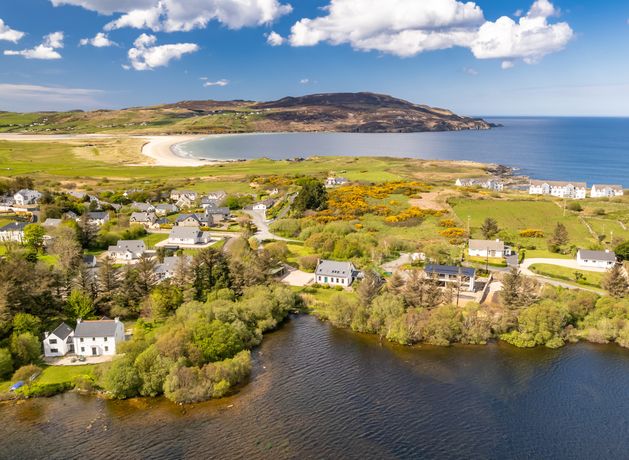Writer and marine biologist Alexander McMaster got his taste for the sea at Rinnaraw
Asking price: €750,000
Agent: Savills (01) 618 1300
“I breathed it in, salt air, and then here it was, spread out glistening below. The final moments of sunset vanished over its brink, the sea which bounds the world… greeting me, an old friend — The Atlantic…”
Thus wrote Alexander McMaster in The Smell of the Atlantic, an account of his journey by tandem bicycle from Cairo to the Namibian coast of Africa en route to Cape Town.
The writer and diver grew up cheek by jowl with his “old friend” at Rinnaraw, located on the coastline of Donegal alongside a deep lough.
Little wonder that both he and his brother pursued a career that’s deeply linked to the sea. “My brother and I both grew up in that house and now work at sea. I am actually on my way to Greece for some diving work now, and he works as a cartographer mapping the seabed,” Alexander says.
One of the bedrooms
“I had a small sailing boat in my teens and in the summer, I’d explore so many bays, beaches, caves and all sorts of things along the coast… and that’s before you even come on to the mountains.
“And just go a wee bit west, drive 15 minutes or so and you get to the Gaeltacht’s stunning landscape with Bloody Foreland, the Poison Glens. You’ll think you’re in the Highlands of Scotland.”
A qualified marine biologist, Alexander is also a writer, ecologist and professional diver, who has worked on fishing conflicts in West Africa and on rescuing migrants in the Mediterranean.
“The house is directly under the flight path of the coastguard helicopter, which might have inspired some of my work in search and rescue,” he says.
The entrance hall
Looking out on the shores of a lough-full of brown trout and located a stone’s throw from ‘mackerel-crowded seas’, Rinnaraw was built to be an angler’s paradise. It even has its own rod room.
“Dad was a fishing instructor and ghillie on the lough. He was never very keen on catching big fish; he was happy with a little brown trout. He set up a school there to teach fly fishing so we learned to fish from a very young age.
“Seisiagh Lough is a limestone lock that’s very, very deep. That’s why you even have Arctic char [a rare and endangered fish]. It’s brilliant for brown trout. That’s why Dad moved there. They moved in just a week before I was born in 1995.”
The house is designed to be “homely and traditional but also modern and open”, Alexander says.
“There is a traditional feel to the place but at the same time, you have spaciousness and openness and I think they wanted to create that balance.”
Owner Alexander McMaster
A long and narrow entrance hall at ground level leads to a bathroom at one end with a moderately-sized study and bedroom to the left.
To the right, we enter the home’s showpiece — a 384 sq ft living room, which, despite its space, “can be quite cosy, especially in the wintertime”, says Alexander. The room lies under ancient beams recovered from a local linen mill and is dominated by a huge brick hearth. “That fireplace is really the heart of the house. It turns out a lot of heat and we spent a lot of winter evenings sitting by it.”
Ships seeking shelter from the raging Westerlies in the Atlantic often fled into Sheephaven — a mispronunciation of Shipshaven — only to run up on a treacherous local sand bar lurking there. Their loss was a gain for local housebuilders.
“If you look on the flagstones (in the hearth) you can see the marks of shellfish. This is because they’re from a shipwreck within walking distance of the house, the SV Florence, wrecked in 1900 on its way from Galway to Derry with a cargo of flagstones,” says Alexander.
To the rear of the living room is a cottage-style kitchen where an Aga cooker sits amid a redbrick surround.
To the left is a utility room, while a door on the right leads to what every angler dreams of: a rod room.
“Parts of the house were built for coming back in from the water so there is a room where dad kept fishing rods. It’s really a conservatory, though he called it a rod room,” says Alexander.
The exterior of the property
“Like all the main (south-facing) rooms, it gets a lot of sunlight and is very warm in summer. With the very high ceiling, it’s a beautiful place to sit in summer with a cup of coffee. We’d also dry the onions there from the enormous vegetable garden.”
Double doors from here open onto a terrace overlooking the lough. “On a good day it can be beautiful and even on a bad day it’ s a place to enclose yourself in and feel the storm around you battering the house while you’re cocooned in that room.”
Linked to the rod room are a garage and workshop to the side of the house, among several utility areas.
The living room
Upstairs, there’s a big landing with “an incredible view” that would certainly appeal to bird watchers. “We’d set up binoculars and look out to see kingfishers and all kinds of birds.
“We’d even get to know some individuals. There was a heron always standing in the same spot. We named him Frank. A pair of ducks nest in the same spot so we’d watch the ducklings grow up each year.
“In the middle of the lough, there’s an island built by Neolithic people (a crannóg). As a teenager I’d swim out to it. The longest travelled birds in the world nest there — artic terns — the only ones that travel from Antarctica to the Arctic.”
Another reception room
Off this massive landing are three bedrooms, one ensuite, and a bathroom. Internal accommodation is sizeable for a four-bed home, reaching 2,486 sq ft in total — plus plenty of outbuildings.These include a large shed to the side of the house (613 sq ft), ideal for boat storage.
The grounds, entered via a stone wall entrance and a long driveway, mainly comprise trees and lawns leading down to the lough, covering about 1.1 acres in total.
“It’s sad for us to see it go, but whoever lives there will be able to benefit from the same things that we did. We had a great grounding, growing up there for almost 30 years.
“It’s perfect for a young family. Even just thinking about children growing up there the way that we did could be a fantastic legacy for the place.”
Savills is asking for €750,00 for Rinnaraw.







